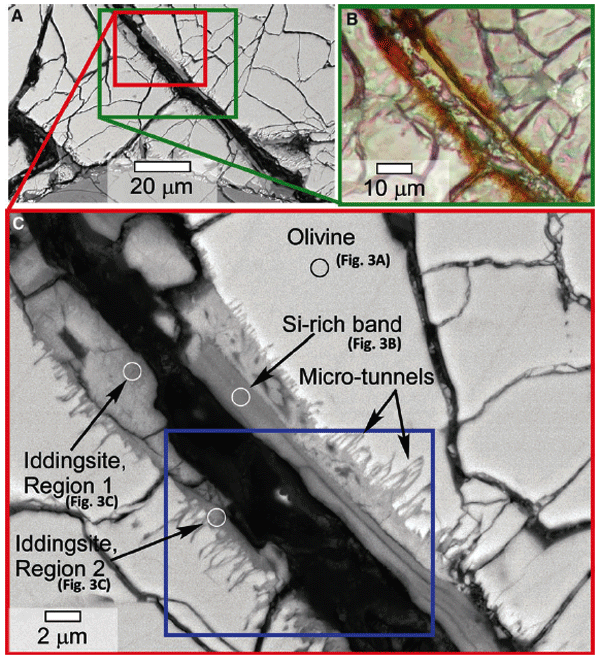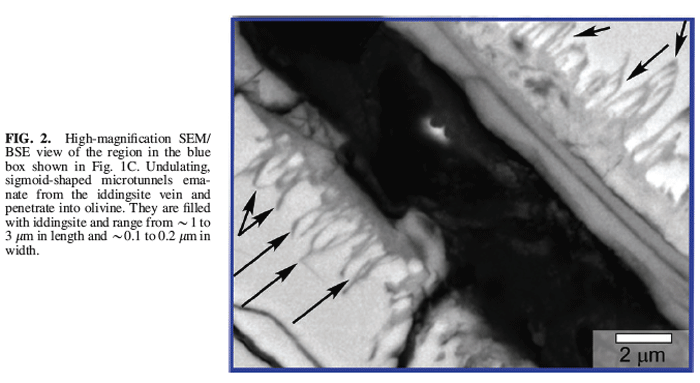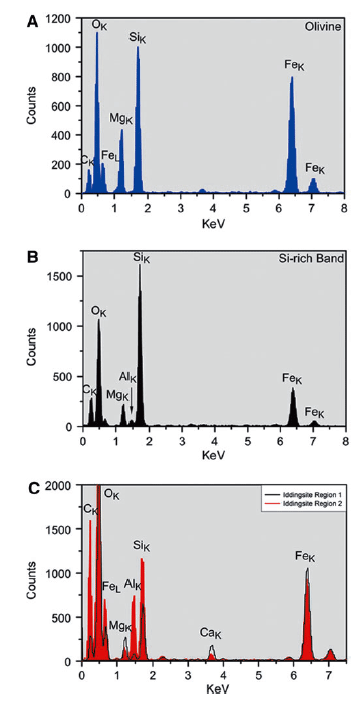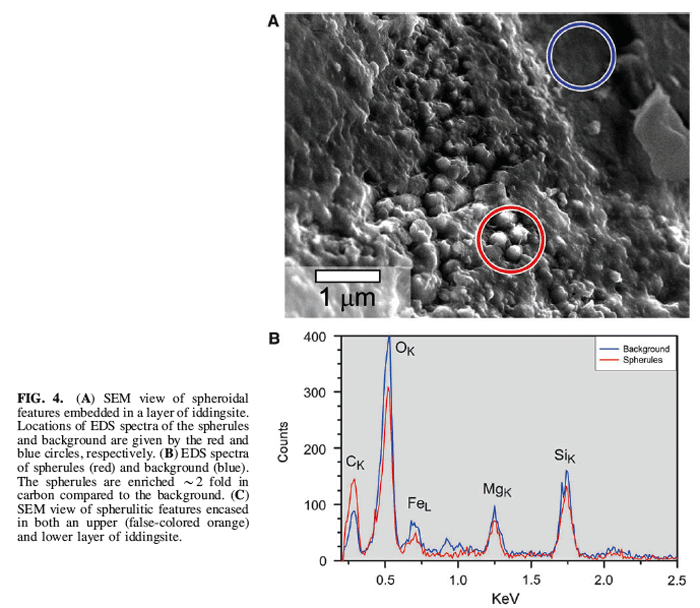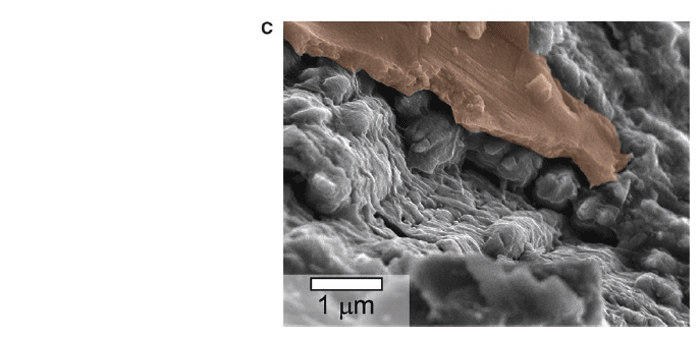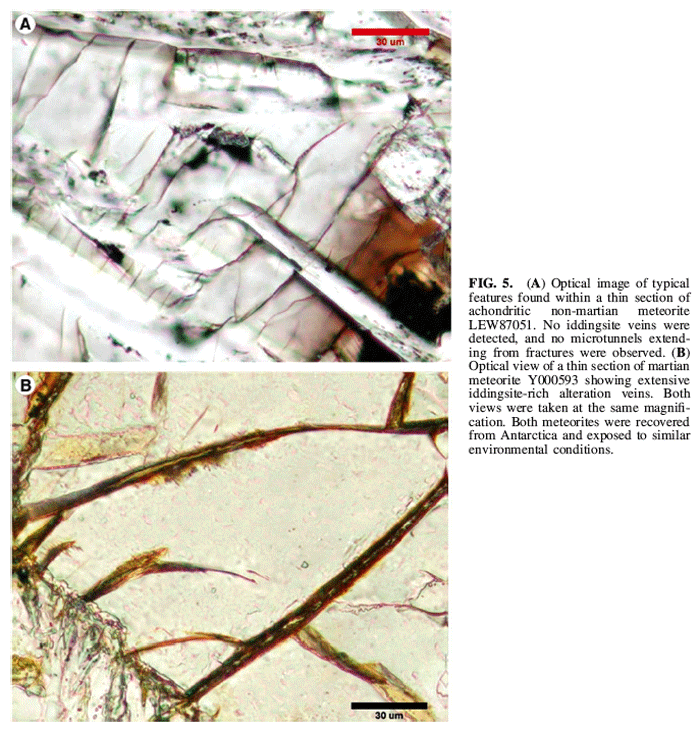.
1.03.2014
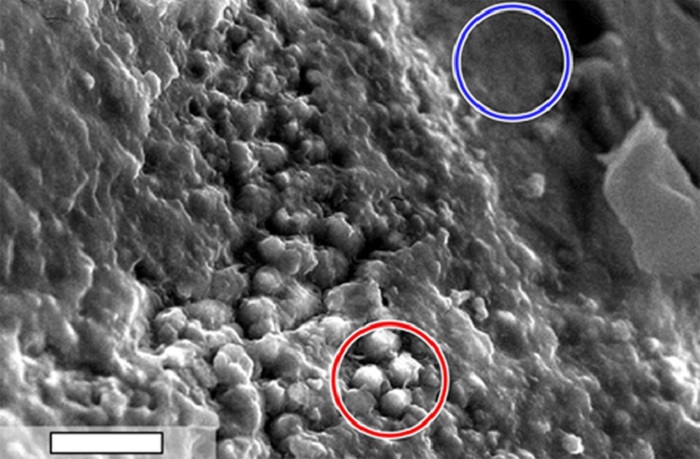
This scanning electron microscope image shows speroidal features embedded in a layer of iddingsite, a mineral formed by action of water, in a meteorite that came from Mars.
.
A meteorite from Mars has been studied up-close and scientists have detected tiny structures that could be interpreted as having a biological origin.
This moment of déjà vu is brought to you by a new paper published in the February issue of Astrobiology where a team of scientists from NASA’s Johnson Space Center in Houston, Texas, and the Jet Propulsion Laboratory in Pasadena, Calif., describe the results of work on a 14 kilogram (30 pound) meteorite called Yamato 000593 (Y000593). The meteorite sample contains strong evidence that Mars used to be a lot wetter than it is now, but the researchers also report on the discovery of evidence for “biological processes” that occurred on the Red Planet hundreds of millions of years ago.
Although this sounds exciting, there will likely be some skepticism, but the researchers appear to have foreseen the media circus that “Mars life” always inspires and refused to appear overly excited of some pretty fascinating evidence for ancient microbial life.
In 1996, President Clinton made a high profile announcement on national television that evidence for life had been discovered by NASA scientists inside another Martian meteorite called Allan Hills 84001 (ALH84001). The discovery focused around scanning electron microscope images of the microscopic detail of ALH84001. The team, led by David McKay of Johnson Space Center, identified “biogenic structures” inside the meteorite that was theorized to be formed by indigenous life on Mars.
The controversial media storm surrounding that 1996 announcement stirred a backlash that threw McKay’s team’s findings into doubt. However, McKay’s team defended the work after ruling out terrestrial contamination and other factors that may have created the nanometer-sized worm-like structures. McKay also worked on the Y000593 study until his death in February 2013.
This new work focuses around a meteorite that was discovered in the Yamato Glacier, Antarctica, by a Japanese Antarctic Research Expedition in 2000.
Analysis of the meteorite shows that it formed on the surface of Mars 1.3 billion years ago from a lava flow. Then, around 12 million years ago, a powerful impact event shattered the region, blasting quantities of Martian crust, containing any hypothetical lifeforms (and evidence thereof), into space. These chunks of Mars rock then traveled through interplanetary space until one of the samples, Y000593, encountered Earth and fell to the surface as a meteorite, falling on Antarctica some 50,000 years ago.
There are many known samples of Mars crust that have fallen to Earth as meteorites and are considered incredibly valuable scientific specimens that can be used as time capsules into Mars’ geologic past. These meteorites are nature’s ‘sample return missions,’ no spaceship required.
“While robotic missions to Mars continue to shed light on the planet’s history, the only samples from Mars available for study on Earth are Martian meteorites,” said lead author Lauren White, of NASA’s Jet Propulsion Laboratory, in a news release. “On Earth, we can utilize multiple analytical techniques to take a more in-depth look into meteorites and shed light on the history of Mars. These samples offer clues to the past habitability of this planet. As more Martian meteorites are discovered, continued research focusing on these samples collectively will offer deeper insight into attributes which are indigenous to ancient Mars. Furthermore, as these meteorite studies are compared to present day robotic observations on Mars, the mysteries of the planet’s seemingly wetter past will be revealed.”
.
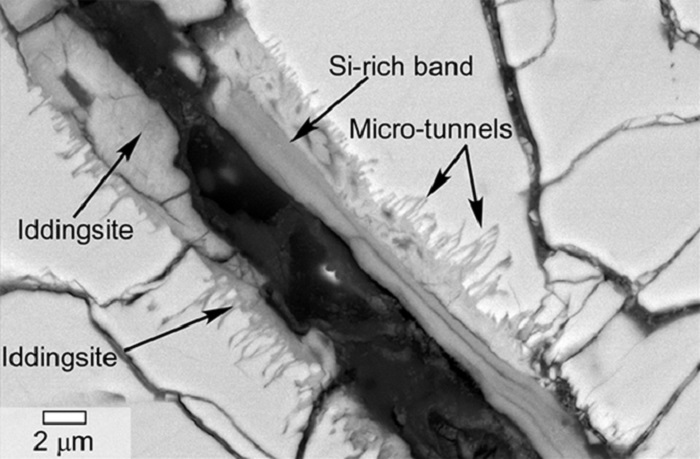
This scanning electron microscope image of a polished thin section of a meteorite from Mars shows tunnels and curved microtunnels.
.
In their research, the scientists describe features associated with Martian clay deposits — micro-tunnels thread throughout the Y000593 sample. When compared with terrestrial samples, the Martian shapes appear to closely resemble “bio-alteration textures” in basaltic glasses. This basically means that this Mars meteorite contains microscopic features that resemble mineral formations created by bacteria on Earth.
Another factor is the discovery of nanometer to micrometer-sized spherules sandwiched between the layers of rock in the meteorite. These spherules are distinct from the minerals inside the rock and are rich in carbon, another sign that they may have been formed through biological interactions inside the rocky material.
The First Rule of “Mars Life”: Don’t Talk About “Mars Life”
Is this proof of Martian bacteria munching through Mars rock? Sadly, that’s one conclusion that cannot be made from this study and the researchers are very cautious not to write the word “life” at any point in their publication — it’s replaced by technical terms like “biogenic origins” and “biotic activity.”
“We cannot exclude the possibility that the carbon-rich regions in both sets of features may be the product of abiotic mechanisms,” the scientists write in their paper. ‘Abiotic’ means mechanisms that are not caused by microbial life, such as some chemical reaction in the rock’s geology. “However, textural and compositional similarities to features in terrestrial samples, which have been interpreted as biogenic, imply the intriguing possibility that the martian features were formed by biotic activity.”
Their caution has been applauded by other astrobiologists. “(The authors) have done well not to cry wolf and to scientifically speculate on the tubules’ origins, accepting that, as of yet, they do not know whether they are of biological origin or not,” said Louisa Preston of the U.K.’s Open University.
“This is no smoking gun,” said White. “We can never eliminate the possibility of (terrestrial) contamination in any meteorite. But these features are nonetheless interesting and show that further studies of these meteorites should continue.”
Since the 1996 ALH84001 controversy, many other researchers have come forward with meteorite studies that appear to show evidence for life on Mars and other interplanetary locations, but most have been published in sketchy journals with little to no peer review process, which serves to blur valuable research being carried out by astrobiologists. Therefore, skepticism for any Mars life study is often high.
So, until we can detect and analyze DNA of extraterrestrial origin or have the ability to return pristine samples from Mars, work like this will be filed under “fascinating but not conclusive” in the profound hunt for life beyond Earth.
Quelle: D-News
.
Update: 2.03.2014
.
Putative Indigenous Carbon-Bearing Alteration Features in Martian Meteorite Yamato 000593
.
